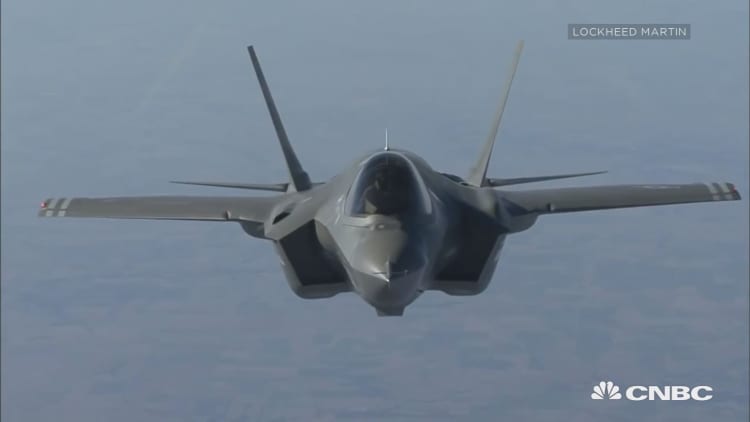
Lockheed Martin's F-35 Lightning II is a radar-evading stealth fighter jet whose cost overruns and development delays have generated many headlines. This program, which has yet to be deployed in a combat capacity, was commissioned by the Pentagon in 1995 and has a projected cost of $1.5 trillion over the next 55 years, making it the most expensive weapons program in U.S. history. What hasn't been the subject of as much ink, however, is the antiwar Democratic socialist senator who supports keeping the program in his state of Vermont: Bernie Sanders.
The plan is for the Vermont Air National Guard based at the Burlington National Airport to be the first to get the plane, replacing the aging F-16s, starting in 2019. It will be the first time the Air Force puts a new fighter bomber at a commercial airport in the U.S. And it has triggered a backlash among local residents over noise and other environmental issues. Last week, a federal judge heard arguments over a lawsuit against the U.S. Air Force regarding F-35 fighter jets.
During his recent Democratic primary campaign, Sanders contrasted his policy proposals with the more hawkish ones put forth by former Secretary of State and presumptive nominee Hillary Clinton, so his involvement in a costly project for the military industrial complex may seem to clash with his rhetoric. In a February article called "Bernie Sanders Loves This $1 Trillion War Machine," The Daily Beast took the senator to task for this very thing.
"The socialist trumpets his antiwar record," the article said. "But he doesn't mind expensive war machines — if they're based in his home state."
A closer look, however, suggests that the senator has just been doing what he was elected to do: seeing to it that his state enjoys a steady flow of jobs and dollars. He's also bolstering Vermont's reputation as a good place for the aerospace sector to do business, even if that's not the first thing that comes to mind.
"People don't think of Vermont as an aerospace state; they think we're all cheese, maple syrup and skiing," said Patricia Moulton, secretary of Vermont's Agency of Commerce and Community Development. "We have a very robust aerospace sector, and we have a number of advanced tech firms that find Vermont a great place to do business."
She said that the two largest aerospace companies in Vermont are GE Aviation and UTC Aerospace Systems, and she also noted the presence of another 30 small to mid-sized companies. Altogether, she estimated that this accounts for more than 2,000 jobs, which the F-35 program is positioned to complement.
"The F-35 accounts for over 1,400 direct and indirect jobs, with an economic impact of over $124 million in Vermont," said Eric Schnaible, F-35 International Communications Manager for Lockheed Martin. This figure accounts not only for 1,100 jobs with the Vermont Air National Guard, but with jobs within the aerospace sector and other local businesses. While 45 states and Puerto Rico are involved in the production of the aircraft, Vermont specifically is home to three supplier locations, and according to Business Insider, the plane's bay doors and GAU-22/A gun system are both produced there.
The 1,400 jobs may not sound like a lot, but Chittenden County, where Burlington is located, has a population of only 161,382 people. It would have an enormous negative impact on the local economy if 1,400 of those people all simultaneously become unemployed.
The jets will also play a role in the state's economy in 2019, when 18 are scheduled to be stationed at Burlington International Airport as part of the Vermont National Guard program to grow its active-duty maintenance force. Gene Richards, the airport's director of aviation, said that those F-35s represent the future of the Guard's relationship with Vermont. The program extends the financial contribution of the Guard well into the future by picking up where the widely used — and soon to be replaced — F-16 will soon leave off.
Richards said that it's not only Sanders who supports keeping the hardware in Burlington. He said that Vermont Gov. Peter Shumlin, Lt. Gov. Phil Scott, Sen. Patrick Leahy and Rep. Peter Welch have all done their part to keep the program where it is, and he characterized their attitudes as "very supportive." A look at the numbers makes it easy to see why.
"There's at least 1,100 Air National Guard jobs involved with F-35," said Moulton of Vermont's Agency of Commerce and Community Development. "We estimate there's about $50 million in direct payroll, and the program will involve some pretty decent upgrades to the Vermont airport."
She added that her agency expects the program to stimulate growth in the aerospace sector by creating business for local suppliers. So what would happen if the program didn't have a home in the state?
The F-35 accounts for over 1,400 direct and indirect jobs, with an economic impact of over $124 million in Vermont.Eric SchnaibleF-35 international communications manager, Lockheed Martin
"Our fear is that if it didn't have a mission in Vermont, instead of 1,100 jobs, we'd probably only have 100 jobs," Richards said. "We believe the investment of this aircraft ensures it will be here for years to come. We really think this is a tremendous opportunity for the country and for the state of Vermont."
Be that as it may, the F-35's path to deployment has been a long and arduous one. It's also been an expensive one.
The F-35B, one of three variants of the jet, was declared operational in July 2015 by the U.S. Marine Corps, 14 years after Lockheed Martin first won the contract and at a final cost of $134 million per plane, according to The Wall Street Journal. According to Vanity Fair, the Department of Defense had originally said the jet would be "combat-capable" by 2010, a prediction that was off by five years.
Oh, and let's not forget the $55 billion spent on research, development, testing and evaluation; $319 billion spent on procurement; $5 billion spent on military construction and $1.1 trillion in operating and support costs, according to the F-35 Lightning II Program Fact Sheet's Selected Acquisition Report 2015 Cost Data. Altogether, that gives this program a price tag of $1.5 trillion, making it by far the most expensive program in military weapons history.
The F-35 has also encountered numerous technical problems, and they're not small ones. According to The Air Force Times, the plane has experienced "catastrophic engine failure," and according to The Washington Post, it experienced "life-threatening" ejection-seat malfunctions in October 2015, three months after the U.S. Marine Corps declared the B variant operational.
CNBC.com reached out to Sanders for comment, and his office responded with a link to a statement on the senator's official website about the stationing of the F-35A at Burlington International Airport in mid-2019. However, at a 2014 town hall meeting in New Hampshire, Sanders was asked about his continued support for the program, and he said that it's not the plane that he supports but the jobs and revenue that it brings to his state.
"In the real world, if the plane is built … and if the choice is if that goes to Vermont … South Carolina or Florida, what is your choice as a United States Senator?" he asked. "Do you want it to go to South Carolina? ... My view is that given the reality of the damn plane, I'd rather it come to Vermont than to South Carolina. And that's what the Vermont National Guard wants, and that means hundreds of jobs in my city. That's it."
While this statement doesn't offer much in the way of insight into Sanders' feelings about the military industrial complex, it does say one thing quite explicitly — the F-35 is a boon to Vermont's economy, despite its checkered history of high costs and delays. Richards said that in his experience, those things come with the territory when it comes to any piece of high-velocity hardware, and if the end result is a safer product, he's fine with that.
"This is typical for a government-funded new aircraft," he said. "It typically takes longer. But I would prefer that they take the time to get it right. I'm not in a rush to see it make a deadline. The finish line is safety."
— By Daniel Bukszpan, special to CNBC.com





